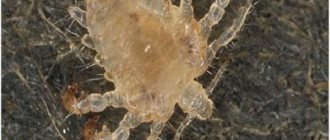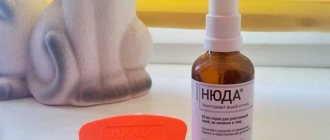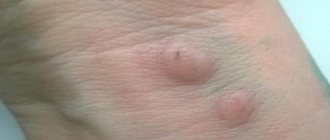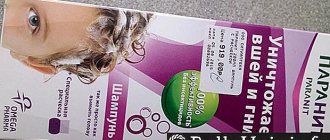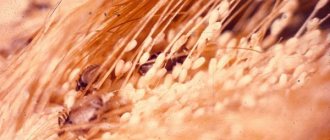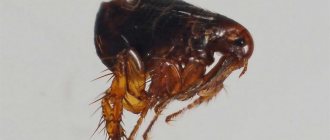Modern medicine has proven that nervous stress, anxiety and increased emotional arousal can be the cause of many diseases. There is an opinion that pediculosis is no exception. Despite the large amount of information about this disease, many people are interested in whether lice can appear on nerves and provoke the development of pediculosis? To answer the question, we need to consider all possible causes that contribute to the symptoms of the disease.
Versions of the appearance of lice from nerves
When they say that all diseases are caused by nerves, there is some truth in this. A person experiencing stress becomes vulnerable, including to parasites. His immunity decreases, and it is more difficult for him to cope with the symptoms of diseases. In a stressful situation, a person increases the production of the so-called “stress hormones” adrenaline and norepinephrine, which is why he develops a specific odor that is attractive to parasites. In addition, in a depressed and upset state, a person may neglect hygiene, which is why he simply will not notice the initial stages of damage, when there are not very many insects yet.
But stress is simply an unpleasant companion to lice infection, but not the reason why lice may appear. However, people have absolutely fantastic explanations for the appearance of lice:
- lice constantly live in the human body, it’s just that in normal life they do not come to the surface of the scalp and do not manifest themselves in any way, but are activated under stress;
- in a stressful situation, tubercles appear on the scalp, in which nits spontaneously germinate, from where lice then appear;
- lice multiply faster in a person who is nervous, so it is more difficult to remove them;
- In principle, lice and nits cannot be removed by any means; they may subside for a while and not cause itching, but at the slightest stress they manifest themselves again.
None of these versions has scientific confirmation. The connection between stress and the appearance of lice has not been identified.
How to get rid of lice?
The fight against the disease must begin as soon as it is discovered. You should not hesitate, otherwise the effect will not be so fast. Basic principles of lice control:
- It is necessary to remove not only the insects themselves, but also the nits. Therefore, it is recommended to carry out the treatment more than once.
- To combat lice, there are many modern means, shampoos, that are destructive to lice and nits, and are harmless to humans. Previously, kerosene was used for these purposes, and now some people prefer it. Tar soap was also used, but it does not kill lice, it only relieves itching.
- Combing with special thick combs gives a good effect. They are especially recommended for those for whom the use of insecticides is contraindicated: pregnant women, allergy sufferers and young children. To make nits easier to separate from hair, you can use vinegar compresses - they dissolve the glue that attaches lice eggs to the hair.
- No hair - no lice. These parasites exist only on the surface of the skin covered with hair. Therefore, you can get rid of them by shaving your hair bald. Of course, this method is more suitable for men.
- Be sure to wash and iron bed linen, toys, and clothes.
- Folk remedies (decoctions, tinctures, etc.) for lice are ineffective, but they can be used if you carefully comb the hair from nits with a special comb.
- The shell of nits is very durable, so not all products work on them.
- If one remedy does not help against lice, you need to choose another - and always with a different active ingredient. When used repeatedly, parasites develop resistance to the same product.
Why head lice cannot appear due to stress
Can lice appear due to nervous conditions? Of course not. The mental and psychological state of a person and the life situations in which he finds himself are not the cause of parasite damage. Lice are parasites that enter the human body from another person. This is the only cause of head lice. You cannot catch lice from pets or get them in any other way.
If a person has lice, he got them in one of the following ways:
- with direct contact: lice can crawl from one head to another;
- when exchanging hats;
- when using combs and other hair accessories of an infected person;
- through clothing and personal belongings - this is how body lice are transmitted;
- through sexual contact - this is how they become infected with pubic lice.
You can pick up lice in public places - on seats and backrests, headrests in public transport, in beauty salons, in swimming pools and saunas. In any place where there may be people with lice, you can get these insects on your head. They are not afraid of water and can live in it for some time, so cases of lice infestation on beaches are not uncommon.
A louse can live outside the human body for up to two days. So even if you find yourself in a completely deserted space, this does not mean that you cannot become infected with lice. The insect can be on any surface from which a simple one will crawl or fall on you. But in any case, the parasite did not appear out of nowhere on its own. It came from an infected person. It did not spontaneously arise from the stress you are experiencing.
How does lice infection occur?
Not all people know how lice pass from one person to another, and therefore they believe that the parasites fly or jump, although in reality they just run quickly. For this reason, infection usually occurs through close contact between a healthy person and a sick person. Head lice can move through people's hair and spread to another person, so people with long, thick hair are more likely to get head lice.
Symptoms of lice do not appear immediately after infection, but after a week or several, because the parasites need to get used to the new host and conditions. Lice feed on human blood by piercing the scalp with their proboscis. Lice also have highly developed salivary glands; their saliva prevents blood clotting, which allows the insect to get enough, and causes itching in the host. The bites look like small red spots, which can also be used to determine the presence of lice.
Lice feed several times a day and live for about a month. The female lays eggs and attaches them to the hair so that it cannot be washed off with water, and a week later new insects hatch from the nits. The period of egg maturation is influenced not by water, as is supposed, but by the ambient temperature.
Why is the appearance of lice explained by nervous soil?
There is a sign that is equally characteristic of stress and head lice. It's an itch. With lice, the scalp itches unbearably. People also often scratch their heads when they are nervous. Therefore, an explanation emerged as to whether lice can appear from nervous stress. People believed that first they scratched their heads, and then lice appeared because of this. If this happened, it was a coincidence. Or the person actually caught lice, began to itch, became constantly nervous because of this, and eventually brought himself to a state of stress.
What can the symptoms of head lice mean?
Based on reliable knowledge about possible methods of infection with head lice, we can answer the question of whether lice can appear from nerves in humans. It is known that this type of parasite cannot tolerate hunger and quickly dies without human blood. To maintain life, lice need to eat at least three times a day. Therefore, they are not able to remain in a sleeping state for a certain time, becoming more active only during nervous stress.
Where do scientifically unsubstantiated theories of the appearance of lice come from and why are people still interested in whether lice can appear from stress or a nervous disorder?
The explanation for the current situation is that many people mistake other skin diseases with similar symptoms for pediculosis:
- Psoriasis. The symptom is itching of varying intensity, which intensifies during periods of emotional arousal. Before diagnosis, a patient may believe that he is infected with pediculosis. Dermatitis. The disease can appear during a nervous breakdown and occurs without the presence of parasites. Scabies. The causative agents are mites that appear on the body, limbs or head. They live under the skin, but do not protrude out and cause constant itching. It is distinguished by the absence of nits and bite marks.
For more information about lice, read the article “What are the symptoms of lice and how to get rid of lice on your head quickly and inexpensively?”
Do children get lice from stress?
Particular attention is paid to the appearance of lice in children. It is known that children are more likely to get lice, but this is only due to the fact that children are more often in groups, in close contact with other children during games and activities. They also love to exchange clothes. There are many more sources of infection in children's institutions. In addition, for unknown reasons, some parents believe that lice are a normal condition for children, that over time they simply outgrow the lice, and the parasites disappear on their own, just as they appeared. Because of this attitude in children's groups, it can sometimes be very difficult to remove lice. Children become infected with head lice again and again. But this does not mean that lice appear on a child’s head on their own or due to nervousness.
Psychosomatics of the disease
The popular belief that the appearance of lice on nerves is real is associated with the psychosomatics of the disease. Itching is also characteristic of stress, head lice, and many other diseases. Nervous stress does not affect the occurrence and development of parasites.
People infected with head lice often recall experiencing stress the day before the disease was diagnosed. After which itching occurred (initially the areas of dislocation are different). Then, miraculously, parasites were discovered. There are many similar stories of lice disease. This is all the influence of psychosomatics.
Based on this relationship, many “legends” arise that tell that lice, like some bacteria and fungi, constantly live in the human body. Stress activates the activity of parasites. Nervous disorders “trigger” the mechanism of development of insects, calmly “dormant” inside the body.
Attention! Scientific theories challenge assumptions about stress. To a greater extent, psychosomatics contributes to the emergence of speculation. It’s convenient for people to blame everything on nerves. Many people do not want to deal with the true causes of infection. Even Louise Hay, an authoritative researcher on the psychosomatics of diseases, refutes this theory.
A person under stress is attractive to lice: is this true?
Contrary to popular belief, lice prefer to settle not on dirty, but on clean heads. Dead skin flakes, fat, and other secretions prevent insects from getting to blood, which is their only food product. So lice is not a disease of dirty people or people with reduced social responsibility. Anyone can get lice, regardless of their social status or hygiene habits.
However, when a person washes poorly or rarely, he acquires a specific smell. It does not wash away sweat, which also attracts parasites. In a stressful situation, this smell intensifies, even if a person maintains hygiene. A person who smells is more attractive to any parasite, including lice. Relatively speaking, if a louse chooses whom it wants to move to - someone who is clean and odorless, or someone under stress who “smells of adrenaline” - she will choose the second one.
In addition, a person scratches himself when stressed, but does not associate the itching with the appearance of lice. So he may miss the moment of infection. Very rarely, but this also happens: some people in a nervous state, on the contrary, become resistant to itching and ignore insect bites. They, too, may not notice the appearance of parasites in themselves.
All this leads to the fact that lice multiply, and a person notices this only when the situation becomes critical. In any case, the cause of lice is another person, not stress.
How do head lice actually appear?
Parasitological specialists have long figured out how lice appear on the head and other parts of the body. The only way lice can get onto a person's head or body is through direct transfer from another person. Typically, such infection occurs through close contact, kissing, hugging, sexual intercourse, games, and wrestling.
It is also possible to transfer lice through hygiene and hair care products - combs, towels, hair ties, hair clips. However, this method is rarer and does not play a significant role in the spread of lice.
On a note
Pubic louse can also be transmitted through water in stagnant bodies of water - all lice are resistant to hypoxia and do not die in water within two days. There are known cases of children becoming infected with pubic lice in India when swimming on public river beaches in poor areas.
The body louse, which spends most of its life on clothes and underwear, can spread with these clothes, provided that several people wear the clothes. Even head louse can be transmitted through fur hats.
There is an opinion, which is not rejected by scientists, that a person in a state of emotional arousal is more attractive to lice. These parasites are guided primarily by smells, and a nervous person’s sweat glands work more actively and he emits a stronger and stronger aroma.
However, given the inactivity of lice and their inability to fly, their reaction to the smell of a nervous person can only be explained by their transfer from one host to another, but not by any means their spontaneous appearance. Therefore, even if there is a dependence on the probability of lice transmission from nerves, it has a very weak effect on the spread of these parasites.
It is also useful to read: About subcutaneous lice in humans: myths and reality
And one more thing: Is lice parasite a dummy that you can’t wash out of your hair with anything, or a really effective thing? (the article has more)
The main popular theory about whether lice can be caused by nervousness is based on the following principles:
- In a calm person, lice and their eggs lie dormant in the head, not showing themselves in any way.
- Stress lice appear, reacting either to thoughts in the head or to constant sweating, and immediately after their appearance they begin to actively feed and bite a person.
There is a lot that is illogical in such a theory.
Firstly, it does not explain how lice initially end up in the head and where they come from on the nerves. After all, they are not inherited, and if they are transferred from another person, why do they freeze for a while?
Secondly, it is now known that lice cannot fast for more than a few days. Accordingly, their sleep in the head for many years is scientific nonsense.
And, finally, it is not clear why a nervous person turns out to be such a more attractive source of food than a calm person that lice cannot even actively feed on the latter.
On a note
This theory has several variations. Among them is the appearance of a bump on the head in which lice are swarming. Allegedly, there are even photographs of such cones. This is also a fiction: lice cannot live under human skin. However, another parasite, subcutaneous mites, is often confused with subcutaneous lice.
It is obvious that such theories are peculiar atavisms of the popular picture of the world, which are gradually becoming obsolete. However, due to their existence, many people use the wrong methods to control parasites and even contribute to their spread.
How to treat head lice under stress
Regardless of what the patient considers to be the cause of lice - stress or infection from another person, it is necessary to treat lice. If you don't do this, the consequences will be severe. A patient with lice scratches his scalp. It develops scratches and more serious wounds that can become infected. The infection will enter the blood. And a person under stress copes worse with illnesses.
You should not use folk remedies, as you need to be very careful to use them. It is difficult to do this in a nervous or depressed state. In addition, such products need to be used several times with a certain frequency. With nervous irritation, it is also difficult to monitor this.
It is better to use pharmacy or specialized insecticidal preparations. These can be shampoos, emulsions, sprays. They are easy to use. One or two applications are often enough. The presence of a stressful situation does not in any way affect the duration of treatment for head lice. It heals equally quickly in irritated or calm people. The treatment result is the same for everyone.
Many remedies are effective. For example, we can recommend products from MediLis: Permifen, Bio, Malathion, Super, Medilis-I. There are detailed instructions for each product. There are treatment options for children.
In addition to treating the head and personal belongings with pediculicides, a mechanical method of removing lice is recommended. After applying the product and leaving it for the specified time to kill lice, you need to comb your hair with a comb. This way you can get rid of dead insects and nits. In addition, such combing can be a very pleasant procedure for a person experiencing stress. It calms and has a beneficial effect on nerve endings. The main thing is not to injure scratches and scratches on the scalp if they appear due to lice. This simple method, together with the removal of blood-sucking parasites, can be the beginning of getting rid of a stressful situation and putting your nerves in order.
There are no lice, but my head itches because of the nerves - what’s the problem?
Lice cannot infest themselves due to stress, but stimulation of nerve endings in the cerebral cortex can provoke unbearable itching on the surface of the head, which others will immediately notice. And since our hands are not always clean, and we don’t wash them very often, anything can accidentally get on them. And this “anything” can remain there after the next touch of the head. So stress is not a direct cause of lice, but the chances of getting lice during nervous excitement increase significantly.
The second cause of unbearable itching of the head during nervous tension is various types of herpes and psoriasis . These diseases often worsen during weakened immunity and are a direct derivative of stressful situations. The same dandruff can cause itching.
It is possible to get rid of them by contacting a doctor who will prescribe treatment. But hygiene can always alleviate the situation. Nizoral shampoo is a good way to combat dandruff. Don't pay attention to the high price and small bottle - it foams phenomenally and solves the problem of dandruff much better than any advertised shampoos.
How long do lice live and what causes them to die?
As mentioned earlier, the average lifespan of lice is 38 days . At the same time, a louse can go without food for 10 days if the ambient temperature is 10-20 degrees Celsius.
Lice die at elevated temperatures - from 44°C .
These parasites are able to survive in water for about two days , floating on the surface. This is how they are transmitted from person to person in the pool. Cold water is also not scary for them.
Lice cannot survive on a person's head if they are shaved bald. They will have nowhere to hide and secure offspring, and adult individuals will be immediately discovered and destroyed.
Some modern drugs can remove lice in one or two applications. We will talk about the choice of drugs below.

